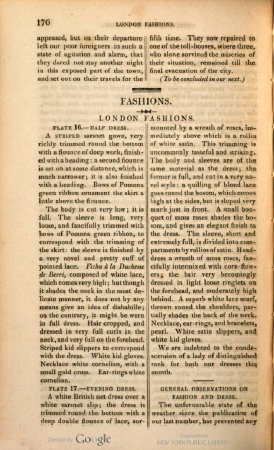Object ID:
2013.4.30
Label/Maker:
Ackermann, Rudolph
Date:
September 1, 1816
Learn More:
Object Story:
The lady in the Ackermann illustration wears a white empire-waisted evening dress that ends at the ankles, displaying ballet slipper-style footwear, which was common during this period. The skirt of the dress is trimmed with two prominent lacey ruffles topped by a band of roses, emphasizing a style in transition between the Empire and Romantic periods. The lady also holds a sheer shawl through crossed arms, donning elbow-length gloves. The neckline of her bodice is cut in a V-shape and trimmed with tight ruffles that extend onto her short, capped sleeves. A rose matching those on her skirt sits at the middle of her neckline in the centre of the bodice. On her head, she wears a wreath of flowers impersonating a Greco-Roman goddess. Laurel wreaths were used by the Ancient Greeks as a symbol of the God Apollo. This type of natural crown came to be associated with academia, a key value of the resurgence of Greco-Roman ideals during the Regency era. 7
Symbolic Comparison:
The use of floral motifs in fashion has spanned throughout history as a measure of societial expression. During the late 18th century and into the early decades of the 19th century, the Neoclassical movement replaced the Baroque and Rococo eras. With an aesthetic grounded in antiquity and the classical beauty of ancient Greece and Rome, dress took on a sleek silhouette that promoted the importance of natural embellishments.8 Floral motifs in this period took the form of garlands and wreaths, as well as bouquets set in Greco-Roman vases.9 In the 1816 Ackermann illustration, the flowers that circle the lady's skirt as well as those that are positioned around the head, evoke the influence that trading clipper ships had on bringing exotic flowers into Britian, Europe, and the United States as an aesethtic trend which influenced both clothing and accessories.
The 1960s brought forth the hippy movement, and in congruence, flower power which was used as a resistence to war and violence. The flower motif was often evident in large, bubbly, bright, and psychedelic styles. Flower patterns were not only confined to bold representations but featured in a more conservative, although still playful manner, as demonstrated in the synthetic flower-covered wedding hat. In both the Ackermann illustration and the 1960s hat, the flower motif creates a design focus that is undeniably representative of each respective era.
References:
7 "Laurel Wreath," Ancient Symbols, accessed November 25, 2020. https://www.ancient-symbols.com/symbols-directory/laurel-wreath.html.
8 Cristina Motta, "What is Neoclassicism?", Useum, accessed November 25, 2020. https://useum.org/Neoclassicism/What-is-Neoclassicism#:~:text=Neoclassicism%20is%20the%2018th%20and,Greece%20and%20the%20Roman%20Empire.
9 Julia S Berrall, "Floral Decoration," Encyclopaedia Britannica, August 12, 2019. https://www.britannica.com/art/floral-decoration.
8 Cristina Motta, "What is Neoclassicism?", Useum, accessed November 25, 2020. https://useum.org/Neoclassicism/What-is-Neoclassicism#:~:text=Neoclassicism%20is%20the%2018th%20and,Greece%20and%20the%20Roman%20Empire.
9 Julia S Berrall, "Floral Decoration," Encyclopaedia Britannica, August 12, 2019. https://www.britannica.com/art/floral-decoration.



